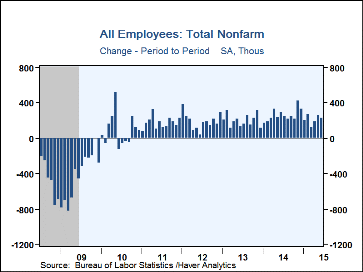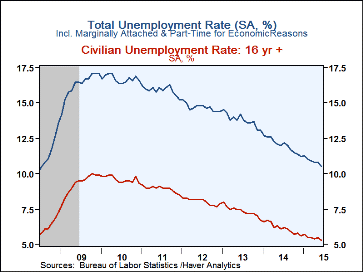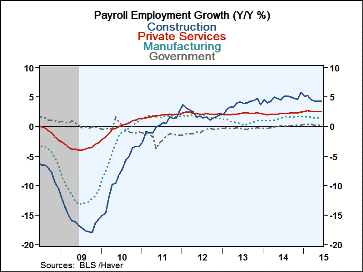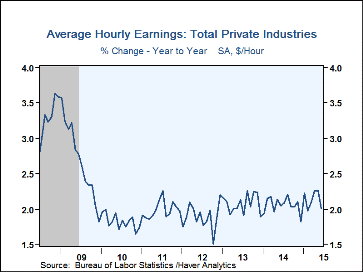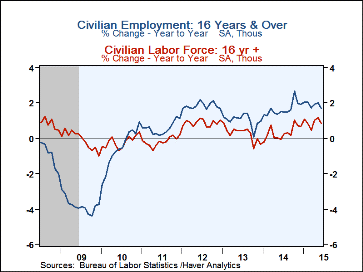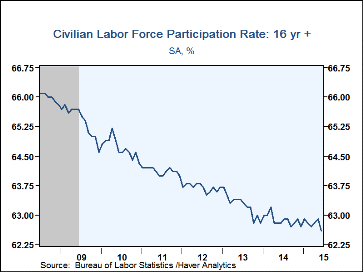 Global| Jul 02 2015
Global| Jul 02 2015U.S. Payroll Employment and Earnings Gains Ease; Unemployment Rate Falls to Seven-Year Low
by:Tom Moeller
|in:Economy in Brief
Summary
Nonfarm payroll employment during June increased 223,000 (2.1% y/y) following a downwardly revised 254,000 May rise. The latest increase fell short of expectations for 230,000 in the Action Economics Forecast Survey. Improvement in [...]
Nonfarm payroll employment during June increased 223,000 (2.1% y/y) following a downwardly revised 254,000 May rise. The latest increase fell short of expectations for 230,000 in the Action Economics Forecast Survey. Improvement in services employment continued to lead the increase in jobs. The unemployment rate fell to 5.3% versus expectations for 5.4%. The overall unemployment rate, including marginally attached and those working part-time for economic reasons, eased to 10.5%. Average hourly earnings were unchanged (2.0% y/y) compared to expectations for a 0.2% rise.
The increase in payroll employment during June followed downwardly-revised increases in both May and April. The latest rise reflected a 4,000 gain (1.3% y/y) in factory sector jobs, no change in construction hiring (4.2% y/y) and a 3,000 decline in mining & logging jobs (-5.5 y/y). In the private service sector, a 222,000 increase (2.6% y/y) in hiring last month was powered by a 64,000 rise (3.5% y/y) in professional & business services employment. Health care & social services jobs rose 52,800 (3.0% y/y) and trade, transportation & utilities employment improved 49,000 (2.0% y/y). Retail trade hiring increased 32,900 (2.0% y/y) and employment in the leisure & hospitality sector gained 22,000 (2.9% y/y). Public sector employment remained unchanged (0.3% y/y), as did federal sector hiring (0.3% y/y). State & government employment declined 3,000 (+0.4% y/y) but local government jobs rose 3,000 (0.2% y/y).
The length of the average workweek remained at 34.5 hours for the fourth straight month. Aggregate hours worked (employment times hours) rose 0.2% (2.4% y/y). For the second quarter, aggregate hours rose at a 1.0% annual rate (2.4% y/y) after a 2.2% Q1 rise. For the last ten years, there has been a 65% correlation between the quarterly change in aggregate hours and the change in real GDP.
Average hourly earnings remained unchanged, the weakest performance in six months. Factory sector earnings declined 0.2% (+1.0% y/y) but construction sector earnings ticked 0.1% higher (2.5% y/y). Earnings in the private service sector remained unchanged (2.2 y/y) as a 0.1% rise (2.5% y/y) in the financial sector was offset by a 0.1% decline (+2.7% y/y) in leisure & hospitality.
In the household survey, the decline in the unemployment rate to 5.3% left it at the lowest level since April 2008. The fall occurred as a 432,000 drop (+0.9% y/y) in the labor force outpaced a 56,000 fall (+1.7% y/y) in employment. The labor force participation rate fell to 62.6%, the lowest level since October 1977. The number of potential workers not in the labor force rose 640,000 (1.6% y/y) to 93.626 million.
The teenage unemployment rate stood at 17.9%, down from the high of 25.9% during all of 2010. For whites, the rate was 15.5%, down from 23.2% in 2010, and for black teens, it was 30.1%, down from 43.1%. For individuals over age 20, the rate was 5.0%, below the 9.0% 2010 high. For whites, the rate was 4.3%, down from 8.1% and for blacks, it was 9.5%, down from 14.9%.
The unemployment rate for those without a high school diploma declined to 8.2% while the rate for high school graduates without college experience fell to 5.4%. For individuals with some college or an associate degree, the rate fell to 4.2% and for college graduates, it fell to 2.5%.
The labor market data is contained Haver's USECON database. Detailed figures are in the EMPL and LABOR databases. The expectations figure is in the AS1REPNA database.
| Employment: (SA M/M Change, 000s) | Jun | May | Apr | Y/Y | 2014 | 2013 | 2012 |
|---|---|---|---|---|---|---|---|
| Payroll Employment | 223 | 254 | 187 | 2.1% | 1.9% | 1.7% | 1.7% |
| Previous | -- | 280 | 221 | -- | -- | -- | -- |
| Manufacturing | 4 | 7 | 0 | 1.3 | 1.4 | 0.8 | 1.7 |
| Construction | 0 | 15 | 30 | 4.2 | 4.8 | 3.7 | 2.1 |
| Private Service Producing | 222 | 246 | 173 | 2.6 | 2.2 | 2.2 | 2.2 |
| Government | 0 | 4 | -2 | 0.2 | 0.0 | -0.3 | -0.8 |
| Average Weekly Hours - Private Sector | 34.5 | 34.5 | 34.5 | 34.5 (Jun.'14) |
34.5 | 34.5 | 34.4 |
| Private Sector Average Hourly Earnings (%) | 0.0 | 0.2 | 0.2 | 2.0 | 2.1 | 2.1 | 1.9 |
| Unemployment Rate (%) | 5.3 | 5.5 | 5.4 | 6.1 (Jun.'14) |
6.1 | 7.4 | 8.1 |
Tom Moeller
AuthorMore in Author Profile »Prior to joining Haver Analytics in 2000, Mr. Moeller worked as the Economist at Chancellor Capital Management from 1985 to 1999. There, he developed comprehensive economic forecasts and interpreted economic data for equity and fixed income portfolio managers. Also at Chancellor, Mr. Moeller worked as an equity analyst and was responsible for researching and rating companies in the economically sensitive automobile and housing industries for investment in Chancellor’s equity portfolio. Prior to joining Chancellor, Mr. Moeller was an Economist at Citibank from 1979 to 1984. He also analyzed pricing behavior in the metals industry for the Council on Wage and Price Stability in Washington, D.C. In 1999, Mr. Moeller received the award for most accurate forecast from the Forecasters' Club of New York. From 1990 to 1992 he was President of the New York Association for Business Economists. Mr. Moeller earned an M.B.A. in Finance from Fordham University, where he graduated in 1987. He holds a Bachelor of Arts in Economics from George Washington University.


